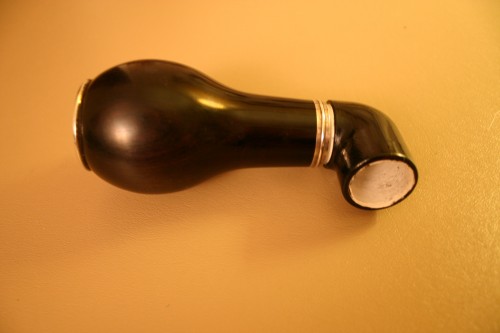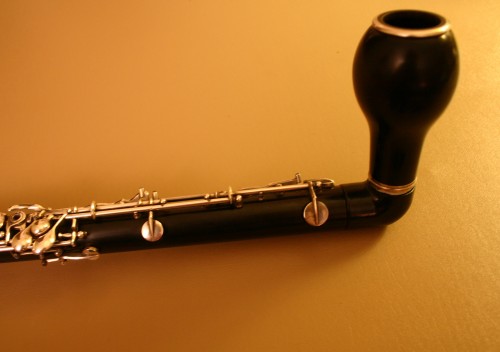
Article: What Does This Have to Do with the English horn?

Believe it or not, this little PVC pipe elbow joint is very important in playing Mahler's Symphony No. 1 or Ravel's Picture at an Exhibition. Why on earth would an English horn player need this to play those pieces you ask? Back when I was playing oboe and English horn in the Amarillo Symphony, we occasionally played pieces like Mahler's First Symphony. One would not think a famous and brilliant composer like Mahler would make this kind of error but he did. He wrote a passage for the English horn that goes a half step below its range. It's understandable how this can happen. Oboes go to a Bb below middle C but the English horn only goes to the B-natural. However, the English horn is a transposing instrument and sounds a fifth below what's written on their part, so I can understand how this very minor detail could have been missed.
So what does the English player do? Well, there are some "extensions" one can buy for $155 at the double reed shops or I could buy an English horn with the extension included but how often would I need this extension? If I were playing in a full-time professional orchestra, I could see it as an investment because the chances of playing pieces requiring this extension might increase but I was playing in an orchestra that performs a nine month season and the cost of the extension would equal the pay for three rehearsals so I looked for alternatives.
I came across a webpage by Larry George who came up with this inexpensive solution! Larry has a PDF that explains how he made a Bb extension for under $2.00 using a PVC pipe elbow! The part if you ever want to try this yourself is PVC part Schedule 40:90 Reducing Ell:Slip x Slip (1 inch by 3/4 inch) and the part number is SKU 43542. It can be found at most hardware stores.

The most difficult part of making this was adjusting the dimensions of the connectors so they  would fit either over the cork tenon of the English horn or inside the bell. I used a Dremel tool and lots of sandpaper to get a tight fit but not too tightly that it would take too much time to change over. There's not a lot of time in the score as I recall to remove the bell, then the extension, and then reattach the bell. You might wonder why I just didn't leave it on and the answer to that is there's a B-natural in another passage and you can't play B-natural with the extension on. I believe someone has invented an extension that solves that problem but I bet it doesn't cost $2. Also, I'm switching back and forth on oboe and with the extension on and the bell angled forward, I wouldn't be able to put the English horn on it's peg when I'm playing oboe.
would fit either over the cork tenon of the English horn or inside the bell. I used a Dremel tool and lots of sandpaper to get a tight fit but not too tightly that it would take too much time to change over. There's not a lot of time in the score as I recall to remove the bell, then the extension, and then reattach the bell. You might wonder why I just didn't leave it on and the answer to that is there's a B-natural in another passage and you can't play B-natural with the extension on. I believe someone has invented an extension that solves that problem but I bet it doesn't cost $2. Also, I'm switching back and forth on oboe and with the extension on and the bell angled forward, I wouldn't be able to put the English horn on it's peg when I'm playing oboe.
I did take a short-cut when making my extension. Larry made some really nice looking cork linings but I was in a hurry so I just used duct tape to pad the connections. It worked just fine. I was rather amazed with how in tune the low Bb came out. I was prepared to either lip up or down to make the Bb in tune but it was in tune quite nicely.
If you're not famiiar with the normal look of the English horn, lo
